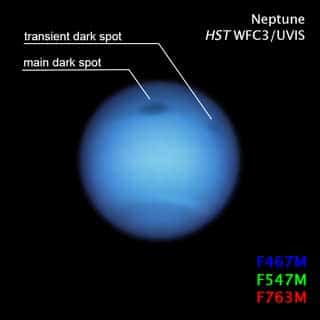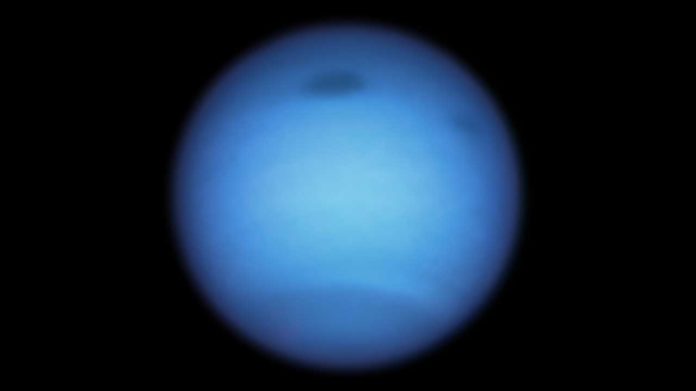NASA’s Hubble Space Telescope recently observed a mysterious dark storm- wider than the Atlantic Ocean on Neptune. The storm unexpectedly steer away from a likely death on the giant blue planet.
Hubble detected the storm in the planet’s northern hemisphere. Following observations shows that it began drifting southward toward the equator, where such storms are expected to vanish from sight.
Not only the storm, but Hubble also spotted another, a smaller dark spot near its larger cousin. It might have been a piece of the giant vortex that broke off, drifted away, and then disappeared in subsequent observations.
Michael H. Wong of the University of California at Berkeley said, “We are excited about these observations because this smaller dark fragment is potentially part of the dark spot’s disruption process. This is a process that’s never been observed. We have seen some other dark spots fading away, and they’re gone, but we’ve never seen anything disrupt, even though it’s predicted in computer simulations.”
Since 1993, this is the fourth dark spot seen on Neptune. It is 4,600 miles across.
Neptune‘s dark vortices are high-pressure systems that can form mid-latitudes and migrate toward the equator. They start out remaining stable due to Coriolis forces, which cause northern hemisphere storms to rotate clockwise due to the planet’s rotation. However, as a storm drifts toward the equator, the Coriolis effect weakens, and the storm disintegrates.

In computer simulations by several different teams, these storms follow a more-or-less straight path to the equator until there is no Coriolis effect to hold them together. Unlike the simulations, the latest giant storm didn’t migrate into the equatorial “kill zone.”
The Hubble observations also revealed that the dark vortex’s puzzling path reversal occurred simultaneously that a new spot, informally deemed “dark spot jr.,” appeared. The latest spot was slightly smaller than its cousin, measuring about 3,900 miles across.
Wong said, “the dark vortex’s puzzling path reversal occurred at the same time that a new spot, informally deemed “dark spot jr.,” appeared. The newest spot was slightly smaller than its cousin, measuring about 3,900 miles across. It was near the side of the main dark spot that faces the equator — the location that some simulations show a disruption would occur.”
“However, the timing of the smaller spot’s emergence was unusual. When I first saw the small spot, I thought the bigger one was being disrupted.”
“I didn’t think another vortex was forming because the small one is farther towards the equator. So it’s within this unstable region. But we can’t prove the two are related. It remains a complete mystery.”
The formation of these storms remains obscure. But, scientists think that the storm’s dark appearance may be due to an elevated dark cloud layer.
The dark spot’s other intriguing feature is the absence of bright companion clouds around it, present in Hubble images taken when the vortex was discovered in 2018. The clouds disappeared when the vortex halted its southward journey. The bright clouds form when the air flow is perturbed and diverted upward over the vortex, causing gases to likely freeze into methane ice crystals.
Wong will present the team’s findings Dec. 15 at the fall meeting of the American Geophysical Union.
